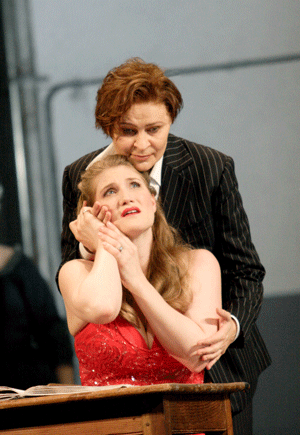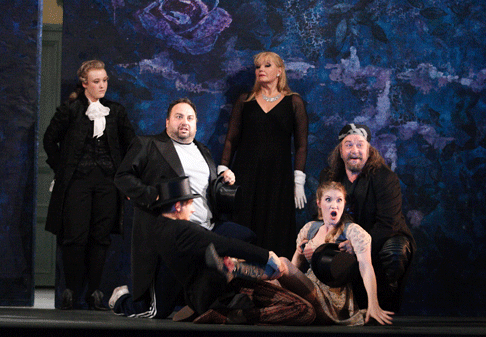30 Jun 2014
Ariadne auf Naxos, Royal Opera
‘When two men like us set out to produce a “trifle”, it has to become a very serious trifle’, wrote Hofmannsthal to Strauss during the gestation of their opera about opera.

‘When two men like us set out to produce a “trifle”, it has to become a very serious trifle’, wrote Hofmannsthal to Strauss during the gestation of their opera about opera.
Unimpressed by the librettist’s pretentiousness, Strauss replied that as a ‘superficial musician’ he couldn’t understand Hofmannsthal’s complex symbolism concerning the nature of Ariadne's salvation and transformation, and that the audience was likely to share his bafflement.
Hofmannsthal is certainly equivocal about why the interaction between the two seemingly incompatible philosophies of art and life presented in Ariadne auf Naxos results in the transfiguration of Ariadne as she lies in Bacchus’ arms at the end of the work. And, Christof Loy’s 2002 production doesn’t really address the opera’s theoretical conundrums; but, in the hands of a superlative cast, it does offer visual and musical sumptuousness and gratification. Back in 2002, the production marked both the re-opening of the Royal Opera House after a major refurbishment and the arrival of Antonio Pappano as musical director. The adventurousness of the striking coup de theatre at the start of the Prologue is an apt symbol of the aspiration and confidence which Pappano has brought to the House, and twelve years on this second revival retains its classiness and ambition.
Ariadne, daughter of Minos, the King of Crete, has helped her Athenian lover Theseus slay the Minotaur and escape from the labyrinth. However, upon their arrival on the island of Naxos, Theseus deserts his saviour and Ariadne languishes alone until Bacchus arrives, having fleed from Circe’s evil clutches. The grieving Princess mistakes Bacchus for Hermes, the messenger of Death, while he believes she is an enchantress — although this time he is happy to submit to her magic.
 Jane Archibald as Zerbinetta and Ruxandra Donose as the Composer
Jane Archibald as Zerbinetta and Ruxandra Donose as the Composer
This is the subject of the after-dinner Opera commissioned by the ‘richest man in Vienna’ which forms Strauss’s second ‘Act’. It is preceded by a Prologue in which we see the Composer learn, with dismay and impassioned disbelief, that his noble opera seria is to be performed ‘simultaneously’ with the dances and distractions of a commedia dell’arte troupe. Consoled by his Music Master, he is forced to make sacrilegious cuts to his score while the comedians and dancers delight in devising the intrusive diversions.
Designer Herbert Murauer opening set is the entrance salon of an affluent mansion: it’s glossy and sleek, but also soulless. His Lordship’s money can buy anything, except sensibility; served by a haughty Major Domo (an imperious Christoph Quest) who can bark out orders but is denied the language of music, the master commissions masterpieces but rates fireworks about art.
Murauer swiftly takes us from the clinical vestibule into more creative, if somewhat chaotic, realms, the whole set magically rising as we descend into the cellar where the artists are at work. The transformation is slick, but it’s a pity that a 40-minute interval is necessary to dismantle the complex machinery that it necessitates and to assemble the Poussin-esque set for the ensuing Opera. Moreover, although the candle-lit emeralds and aquamarines of the ‘island’ are an effective representation of seventeenth-century taste (Jennifer Tipton’s lighting design is particularly atmospheric and emphasises the ‘artifice’ which is such a significant element of Strauss’s dialectic), the classical French Baroque landscape mural has little in common with the modern-period Prologue and there are scant directorial connections between the two parts of the opera. Costumes are similarly confusing: Ariadne dons mourning black, the nymphs and spirits sport eighteenth-century dress (one looks suspiciously like Mozart) and Zerbinetta — her stilletto boots and skimpy dress sluttishly flirtatious — is accompanied by a cast of entertainers dressed respectively in combat gear, a shiny shellsuit, tartan and rockers’ black leather. Ariadne’s cave is a dressing table perhaps to suggest that, peering into the mirror, she is consumed by her own solipsism?
But, things cannot fail to please with Karita Matilla taking the title role for the first time. Wittily self-parodic as the Prima Donna in the Prologue, she tranforms into a ‘real’ diva for the Opera proper, rapturous of voice and expertly balancing nobility with excess. Matilla’s soprano possesses a powerful Straussian lustre, easily capable of soaring over the orchestra, and she sings her long monologues with heartful commitment. But, she also finds variety of colour: recalling her happiness with Theseus in ‘Ein schönes war’ her tone is bright and joyful. And, Matilla demonstrates a strong lower range, particularly when she sings of the ‘Realm of Death’, building this monologue to an ecstatic climax.
Matilla commands the stage but the other principals are no less satisfying. Ruxandre Donose’s Composer was overflowing with adolescent fervour and idealism. Her smooth mezzo is perfect for Strauss’s flowing arioso melodies, and her outburst that ‘Musik ist eine heilige Kunst’ (music is a holy art) was full of elevated feeling and conviction. Donose made engaging use of a wide dynamic range and was totally convincing in her interaction with Jane Archibald’s Zerbinetta. The latter has all the necessary vocal weapons in her arsenal and she had no trouble whizzing nimbly through the coloratura tricks of ‘Großmächtige Prinzessin’ and sustaining a reliable high F. Archibald’s tone is silvery and even in the stratosphere retains its sweetness. She had a good stab at capturing Zerbinetta’s less-than-innocent coquetry and effervescence; and one could forgive the Composer for submitting to the charms of her Prologue number, ‘Ein Augenblick ist wenig’. But, she didn’t have quite enough stage presence or depth of characterisation for this production — a touch more of Despina needed, perhaps?
 Kiandra Howarth as Echo, Wynne Evans as Scaramuccio, Paul Schweinester as Brighella, Karita Mattila as Ariadne, Jane Archibald as Zerbinetta and Jeremy White as Truffaldino
Kiandra Howarth as Echo, Wynne Evans as Scaramuccio, Paul Schweinester as Brighella, Karita Mattila as Ariadne, Jane Archibald as Zerbinetta and Jeremy White as Truffaldino
Roberto Saccà tenor doesn’t have quite enough dramatic energy or openness at the top for the demanding role of Bacchus — it is after all the voice that frees Ariadne from her torment and pain — but in many other ways he acquitted himself well and had the stamina to cope with the unforgiving challenges, and tessitura, of the part. There were some deft comic touches during the tomfoolery of the Prologue, and his overall performance was robust, maintaining focus through to the final duet.
Thomas Allen was typically dependable as the rather frazzled Music Master, the diction superb as always. Ed Lyons had all the high notes, including a secure top B, and delivered the preening Dancing Master’s comic lines with waggishness. Baritone Marcus Werber sang Harlequin’s song with a pleasing cantilena and strong high notes. Tenor Wynne Evans was a powerful Scaramuccio, while Truffaldin was sung with smooth lyricism by bass Jeremy White. Paul Schweinester used his flexible tenor well in the role of Brighella. However, as the commedia dell’arte troupe insinuate themselves into the Opera, choreographer Beate Vollack’s routines at times verged on slapstick and the pantomimesque steps of ‘Die Dame gibt mis trübem Sinn’ — danced in an attempt to cheer up the gloomy Princess — were tiresome.
Echo (Kiandra Howarth), Naiad (Sofia Fomina) and Dryad (Karen Cargill) blended beautifully, especially in their trio commenting on Ariadne’s grief. Howarth’s pure, youthful soprano is just right for Echo’s simple imitations; Cargill’s mezzo is fittingly dark and rich. In the smaller roles of the Lackey, Officer and Wig-maker, Jihoon Kim, David Butt Philip and Ashley Riches, respectively, all performed well.
Supportive of his singers throughout, Pappano brought a surprising mix of luxuriousness and lucidity — there were some very effective pianissimi — to Strauss’s richly textured score. Solos from clarinet, horn, flute and bassoon were beautifully executed in sentimental dialogue with the vocal lines; and the string playing in the overture to the Opera was sorrowful and affecting. The conductor paced the drama with mastery, especially the final duet, controlling the ever-accumulating waves of sound with fine judgment. In Pappano’s hands, Romanticism and Classicism were perfectly blended.
Claire Seymour
Cast and production information:
Ariadne/The Prima Donna, Karita Mattila; Bacchus/The Tenor, Roberto Saccà; Zerbinetta, Jane Archibald; The Composer, Ruxandra Donose; Harlequin, Markus Werba; A Music Master, Thomas Allen; Dancing Master, Ed Lyon; Wig Maker, Ashley Riches; Lackey, Jihoon Kim; Scaramuccio, Wynne Evans; Brighella, Paul Schweinester; Truffaldino, Jeremy White; Officer, David Butt Philip; Naiad, Sofia Fomina; Dryad, Karen Cargill; Echo, Kiandra Howarth; Major Domo, Christoph Quest; Director, Christof Loy; Conductor, Antonio Pappano; Designs, Herbert Murauer; Lighting, Jennifer Tipton; Choreography, Beate Vollack; Orchestra of the Royal Opera House. Royal Opera House, Covent Garden, London, Wednesday 25th June 2014.